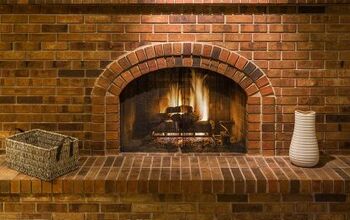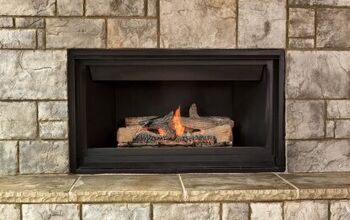Is It OK To Leave A Gas Fireplace On Overnight?

On a cold winter night, it can be comfortable to cozy up by your gas fireplace, so much so that it may make falling asleep much easier. However, you may wonder, is it okay to leave it going during the night?
Is it safe to sleep with a gas fireplace running overnight? No, you should not leave your gas fireplace on overnight as you risk carbon monoxide poisoning. Although it’s never recommended, if your gas fireplace has been properly maintained and designed to run continuously, it may be safe to leave it on.
Regardless, your home should always be outfitted with a smoke and carbon monoxide detector to further prevent any potential hazards. Despite the risks, some people still elect to leave their gas fireplace on during the night.
Let’s examine why this is not recommended and exactly how long you can keep a gas fireplace running. We’ll also outline some general gas fireplace safety tips to help keep your family safe and prevent any possible dangers.
Why You Shouldn’t Leave Your Gas Fireplace On Overnight
Although it may seem like a nice thought to keep your fireplace running over the course of a cold evening, it is always advised against for a variety of reasons.
The first reason being, if you’re sleeping too close to the fire, you run the risk of suffering from smoke inhalation. Stray sparks or heat from the fire could also burn you or set your entire home ablaze. While this may seem dramatic, it is certainly possible.
Regardless, the most common concern with leaving your gas fireplace on is that you risk sickness or even death caused by carbon monoxide poisoning.
What Is Carbon Monoxide Poisoning?
Carbon monoxide is a colorless, tasteless and odorless gas that can only be detected using specialized equipment. Exposure to this gas can lead to sickness, hospitalization and even death.
With a gas fireplace on, carbon monoxide can form when the wood or fuels such as kerosene and propane are not burned off entirely. This gas is often referred to as the silent killer since without the proper detection devices, it’s virtually unnoticeable.
When we breathe, the oxygen we intake reaches our lungs and binds to hemoglobin in our blood. The oxygen is then dispersed via the bloodstream to the body’s cells and organs. However, with the existence of carbon monoxide, it enters your lungs, binds to hemoglobin and is delivered throughout your body.
How Carbon Monoxide Affects You
The more carbon monoxide that your body inhales, the more you are depriving yourself of oxygen. As your cells are depleted of the necessary oxygen you can become gravely sick, pass out or possibly die. Carbon monoxide poisoning is often described as “flu-like” and will typically present itself in the following symptoms:
- Dizziness
- Shortness of breath
- Headache or migraines
- Weakness and confusion
- Chest pain
- Nausea, upset stomach or vomiting
It’s best to avoid leaving your gas fireplace on overnight to prevent carbon monoxide poisoning. Regardless, you should have carbon monoxide detectors installed in your home whether or not you have a gas fireplace.
Can You Get Carbon Monoxide Poisoning From A Gas Fireplace?
Yes, you can get carbon monoxide poisoning from your gas fireplace, which is why you shouldn’t keep it on overnight. Furthermore, you need to provide the proper maintenance and frequently inspect it to ensure that it’s operating the correct way.
How Long Can A Gas Fireplace Be Left On?
Although not recommended, some gas fireplaces are built to be operated continuously – similar to a furnace. This is only true if your gas fireplace has a sealed glass front and is fully vented. Whereas, gas fireplaces that have easily opened doors on the front and are vent-free, should only be operated for two to three hours at a time.
Below, we’ve outlined the types of gas fireplaces and their corresponding safety considerations.
Consider the Cost to Run a Fireplace
Types Of Gas Fireplaces
The most common types of gas fireplaces found in homes can be broken down into three categories:
- Direct vent: Most direct vent gas fireplaces are permitted to be operated continuously because of their sealed glass front and exhaust vent that is outfitted on an exterior wall of your home. This type is also beneficial in homes that don’t have an existing fireplace or chimney.
- Fireplace inserts: Fireplace inserts are exactly as the name implies and can be inserted into existing, wood-burning fireplaces. The vent pipe is easily placed inside the current chimney to release exhaust. As long as the fireplace insert has a sealed glass front, it can be run continuously.
- Vent-free: A vent-free gas fireplace operates similar to an oven and provides a secondary non-vented heat source for the home. They do not vent exhaust fumes outside of the home and should only be used for a couple hours at a time.
It’s important to take into account the type of gas fireplace when determining proper safety precautions.
Gas Fireplace Safety Precautions
In general, gas fireplaces are safe when it comes to toxic gases such as carbon monoxide. However, you should still install a detector within close proximity of your fireplace. This is particularly true is your fireplace is the vent-free type.
The carbon monoxide detector will help you monitor the levels of the gas in your home and be notified when and if it reaches a dangerous level. Here are some other precautions to take when you own a gas fireplace:
- Keep flammable items, children and pets away from your gas fireplace. Aside from having a detector, make sure that you don’t have any curtains or other loose items that could potentially catch fire too close to the fireplace. Small children and pets should also be kept at a safe distance by installing a gate or fence around the perimeter. Even though the flames are behind glass, the glass can very hot and will remain hot for long after the fireplace is turned off.
- Have your fireplace installed by a professional. In order to avoid any potential hazards or prevent your house insurance from becoming invalid, do not attempt to install a gas fireplace yourself. Only a qualified professional will know how to fit the main gas supply. You should also have annual maintenance done on your fireplace to ensure that it is functioning properly.
- Do not attempt to turn on a fireplace that is visibly cracked or damaged. If you notice any damaged parts, there could be a gas leak. In this case, you should contact a reputable heating contractor immediately.
- Do not perform any modifications. Speak with a heating contractor before considering any modifications to the fireplace or the mantle. You don’t want to disrupt the system or cause a gas leak.
- Follow special safety precautions for vent-free gas fireplaces. These include making sure that the unit isn’t too big for the room it’s located in so that it doesn’t remove a dangerous level of oxygen. Also, it should not be run for a long period of time to prevent oxygen depletion and buildup of carbon monoxide.
- Keep your fireplace fan clean and make sure that the outside air vents are free of leaves, snow or other debris.
- Pay attention to unusual flames, odors or the smell of gas. If either of these are present, turn off the fireplace and call your local gas company or a trusted heating contractor.
Maintenance is absolutely crucial for gas fireplaces. You should have a trained professional perform maintenance at least once a year to avoid extensive damage, ensure that it’s working properly and guarantee the safety of your family.
Alternative Ways To Heat Your Home At Night
So you may be tempted anyway to leave your gas fireplace on overnight because you want to keep your home nice and warm for the morning. However, not only is that a bad idea, but it’s dangerous. Below, we’ve listed a few ways you can keep your home warm throughout the night and into the morning without keeping your gas fireplace on all night.
Space Heaters
Space heaters are great, and there are even some power-saving types out there that you can plug in and put into the bedrooms at night time. If you’re worried about the livingroom being cold upon waking, wake up a bit earlier to start your fireplace, and the heat will be going in no time.
Furnace
If you also have an electric furnace, turn this on low during the night time. That way, you can wake up to a nice warm house and not freeze during the night. The furnace will help disperse heat throughout your home while you sleep.
Load Up On Blankets
If it’s not too terribly cold outside, you can throw a few extra blankets onto your bed. That way, you can stay nice and warm. Another good idea would be to get a heated blanket that you can put under your other covers, so you stay toasty.
Wrapping It Up
Although some gas fireplace inserts and direct vent types permit continuous use, it is never recommended to leave your gas fireplace running overnight. Understanding your fireplace and being armed with all the necessary precautions will help prevent any possible health and safety concerns in your home.
Related Guide(s)

Jessica considers herself a home improvement and design enthusiast. She grew up surrounded by constant home improvement projects and owes most of what she knows to helping her dad renovate her childhood home. Being a Los Angeles resident, Jessica spends a lot of her time looking for her next DIY project and sharing her love for home design.
More by Jessica Stone



























